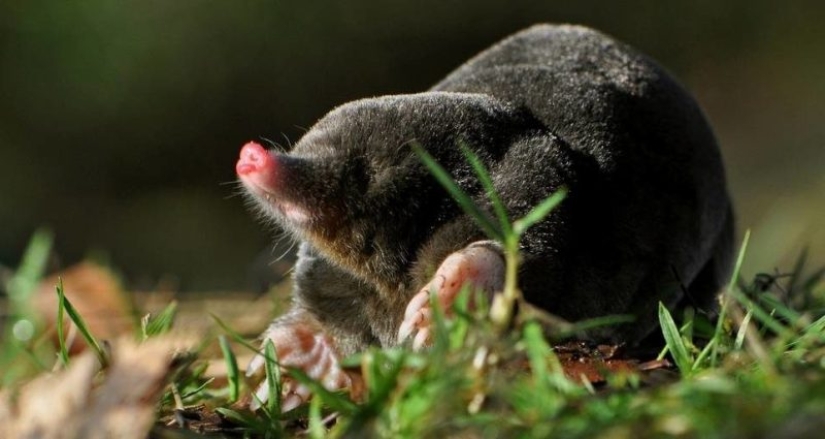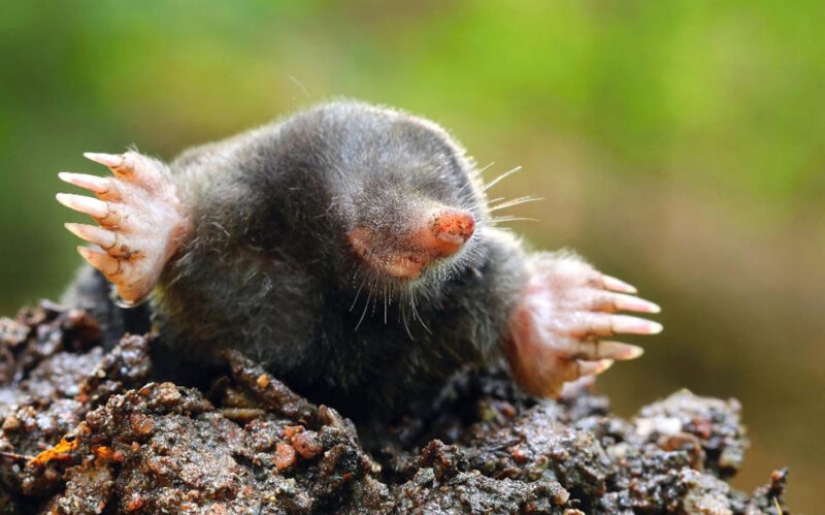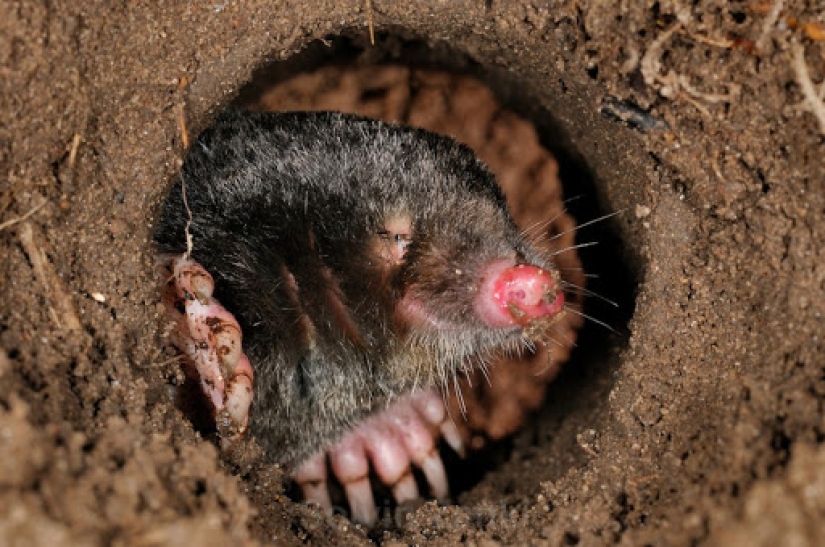"Little Gentlemen in Black Velvet", or What Exactly You Didn't Know About Moles
Categories: Animals
By Pictolic https://pictolic.com/article/little-gentlemen-in-black-velvet-or-what-exactly-you-didnt-know-about-moles.htmlMoles are animals that live next to a person, but only specialists know the details of the life of these babies. Moreover, not everyone has seen a live mole and only a few were lucky enough to touch these amazing creatures. Meanwhile, moles deserve to be admired. This is the opinion of gardener and mole specialist Mark Hamer, who wrote the book "The Secret of the Mole Hole" about small diggers. It contains a lot of interesting information and the most valuable facts we want to bring to your attention.

Moles are miniature, but incredibly strong animals. Their bodies are entangled with steel muscles, but their strongest part is their paws. Evolution has endowed moles with massive and wide paws, each of which is comparable to the width of the head and has two thumbs. But the hind limbs of the animal are frail and look like mice, since they are not used for digging.

Mark Hamer writes that his hands, accustomed to working with a shovel, have considerable strength, but it is not difficult for a mole to strain the muscles of the body, rest his paws and escape even from the strongest grip. Such incredible strength is important underground, where the mole has to turn around in narrow passages and get out from under the rubble.
With a brutal athletic physique, the mole has a cute pink nose, moist like a dog. Moles are covered with short shiny fur, very pleasant to the touch. The skin fits the animal's body loosely, which also helps it when moving in narrow galleries.

Moles are real extreme. In their three-dimensional underground world there is no top and bottom, but there are many obstacles and dangers. It is known that these animals can dig under the foundations of buildings and roads, pass under ditches with water and streams, and even swim across deep rivers!
Despite their agility and super-penetration underground, moles are helpless on the surface. They see very poorly and move slowly, so they become prey to predators very quickly. In this regard, only a need, for example, a flood, can drive a mole to the surface.
It is also worth saying that the mole is a completely unsuitable animal for domestic maintenance. No, an underground inhabitant will not be able to arrange an apocalypse at your home, as a raccoon mole will simply die in captivity, since it is difficult even for a specialist to create suitable conditions for him.
Despite the fact that Hamer sincerely admires moles, he, as a gardener, has to fight with these animals, which interfere with work, creating underground passages where it is completely inappropriate. Mark deals with only one species of these animals - Talpa europaea or the European mole, as it is common in the UK and throughout Europe, except Ireland.

Yes, there are no snakes or moles in Ireland. In this country, you will be told a lot of legends about this, but in fact everything is very prosaic – the ice Age prevented moles from getting to the Green Island. About 7000 years ago, the ice began to melt, and animals migrated north. Someone managed to get to Ireland before it became an island, but the moles were not too quick.
Almost all types of moles that exist in the world today are very similar to each other. Sometimes only a professional will be able to distinguish them. In North America, these animals are more diverse than in Europe, there are as many as seven varieties of them, barely subtly different from their European counterpart.
Strikingly unlike the others, only the American shrew mole, which does not have large paws. He does not dig deep and extended burrows, but is content with shallow pits in soft soil. To dig out such depressions, ordinary paws, similar to rat paws, are enough for him.

North America is also home to the world's largest Townsend mole, whose body length often exceeds 25 cm. Another unique mole of this continent is zvezdoryl. On the nose of this animal there are 22 flexible and very mobile growths, with which the mole feels objects at high speed, looking for food. Scientists have determined that the starfish is able to identify up to 13 objects per second with its tentacles, accurately selecting edible ones from them.
An adult European mole easily fits in the palm of an adult and weighs no more than an empty wallet. If you carefully examine its muzzle, you will notice that the teeth of the underground predator are very small and sharp – they look like fragments of broken glass. The teeth of the mole are erased during its life, as the animal feeds on worms and larvae, inside of which there is soil and sand.

The mole does not have pronounced auricles – they would interfere with it when moving in tunnels. At a cursory glance at the animal's head, it may seem that he does not have eyes, but this is not so – the mole has very small, shiny beady eyes. And the mole also has a short bristly tail, which he raises vertically upwards to determine the height of the underground passage.
The secretive lifestyle of moles and exotic appearance could not but surround them with an aura of mysticism and mystery. In the Middle Ages, moles got no less than black cats, since these animals and their body parts were used in medicine and various magical rituals.

It was believed that if you catch a mole and manage to hold it in your hands until it dies, you can get the gift of healing. Thanks to the works of Pliny the Elder, moles were caught to swallow their fresh hearts – an ancient scientist claimed that this way you can get the gift of clairvoyance. The mole's tail, suspended from the purse, contributed to the fact that money was not transferred in it, and dried paws cured rheumatism and attracted good luck.
There were many other beliefs associated with these animals, thanks to which such a profession as a mole catcher was quite monetary. The people involved in this business were considered healers and magicians and attributed to them the most incredible abilities.

A lot of superstitions are also associated with the moles themselves. For example, they used to believe that whoever caught a white or golden mole would certainly die. Mark Hamer has not yet seen such animals, as they are very rare in nature. The community of mole catchers (it turns out that there is such a thing in the UK) awards a special badge to a person who sends a photo with a white or golden animal.
And the mole once influenced the history of England. In 1702, King William II of Orange, riding near Richmond, fell from a stumbling horse and broke his shoulder. The fault of the incident was a wormhole, into which the hoof of the royal horse got. Despite all the efforts of doctors, the monarch never recovered from the injury and died of pneumonia a year later.

This king came to the throne not quite legally – he overthrew the legitimate monarch James II 14 years before the incident with the mole. In Scotland, William II was very disliked and after his death, moles began to be treated with special respect. There, even today, these animals are sometimes called respectfully - "the little gentleman in black velvet."
In London, in St. James's Park, there is an equestrian statue of William, which has one little secret. If you look closely, you can see a mole hole next to the rear left hoof – this is how the sculptor immortalized the modest contribution of a simple English mole to the history of the kingdom.
Recent articles

Winter is a special time of the year, someone is afraid of her, someone is waiting for snow days to build a snowman or go down the ...

The heroes of their photos are used to humiliate others, cheerfully and carelessly shoot everything on the phone and post the ...

Every day, photographers around the world are looking for new ways to tell stories or capture something we haven't noticed ...